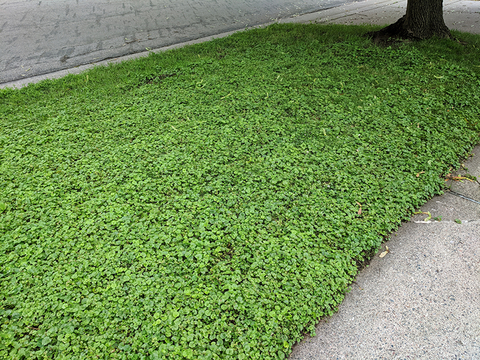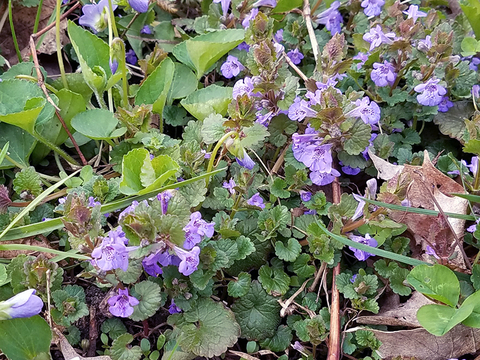Quick facts
- Ground ivy (also known as creeping Charlie) is a member of the mint family with scalloped, opposite leaves, square stems and rooting at its nodes.
- Hand removal can be effective if repeated.
- Chemical control is most effective in the fall.
- Ground ivy does not have accessible pollen and is not a heavy honey producer for bees.
Ground ivy is an unregulated invasive species.
Characteristics
Ground ivy (Glechoma hederacea), also known as creeping Charlie, is an invasive herbaceous perennial plant that forms evergreen mats that spread 1-3 feet and can grow up to one foot tall.
As a member of the Mint family (Lamiaceae), ground ivy is an aggressive ground cover that thrives in shaded, moist, nutrient-poor soil and smells minty when crushed or mowed.
Flowers, fruit and seeds
- Bloom time: early spring to early summer.
- Ground ivy grows purple or blue tubular flowers in clusters of two or more in-leaf intersections (axils).
- Although spreading primarily by stolons, ground ivy can also spread by seed, producing four flat egg-shaped seeds per flower.
Leaves
- Ground ivy has rounded to oval leaves with scalloped edges.
- Leaf veins on individual leaves are palmated.
- Opposite growth.
Stem and roots
- Ground ivy has square stems, a characteristic of most plants in the mint family.
- Above-ground stems called stolons grow horizontally across the ground, and flowering stems grow vertically.
- Ground ivy grows roots at its nodes and sends rhizomatic roots horizontally under the soil surface.
Where it thrives
Ground ivy thrives in damp, shaded areas such as understories of trees and shrubs. Due to its high adaptability, it can grow in most environments.
Large mats of ground ivy can indicate compacted, nutrient-deficient or poorly drained soils.
Ground ivy is suspected to have allelopathic qualities, producing chemicals that reduce growth in other plants, making it a competitor of desirable plants.
Control and management
Ground ivy is an aggressive weed that can be managed in several ways.
Turf
- Hand removal is effective for removing small patches but may need to be repeated.
- Remove all parts of the roots and shoots to prevent regrowth.
- A dense and healthy turf is the best defense against ground ivy encroachment.
- Ground ivy reestablishes quickly but can be controlled with postemergence herbicides containing triclopyr.
- 2,4-D is not very effective in control.
- Chemical control is most effective in the fall. If needed, spring application is also effective.
- In the fall, ground ivy sends herbicides to its roots along with nutrients.
Garden
- Hand removal is effective for removing small patches but may need to be repeated.
- Remove all parts of the roots and shoots to prevent regrowth.
- Broadleaf herbicides can be effective on large patches but can adversely affect desired garden plants.
Benefits to the landscape
Ground ivy is foraged by many different bees during April and May when few flowers are blooming. Although beneficial for nectar collection by pollinators, this weed is not a heavy honey producer for bees, and ground ivy does not have accessible pollen.
When promoting pollinators in your garden, planting diverse flowers and grasses to provide nectar and pollen consistently throughout the year is more effective than ground ivy.
Ground ivy has been used throughout history as an edible and medicinal plant and in many East Coast seed mixes for no-mow lawns.
Conservation, invasive status and native status
- Invasive.
- Introduced.
- Ground ivy is native to Europe and can be traced back to New England as early as 1672.
- This weed, also known as alehoof, was used in ale production before the widespread use of hops.
Plants that look similar
- Common mallow
- Heal-all
- Henbit
- Purple deadnettle
CAUTION: Mention of a pesticide or use of a pesticide label is for educational purposes only. Always follow the pesticide label directions attached to the pesticide container you are using. Be sure that the area you wish to treat is listed on the label of the pesticide you intend to use. Remember, the label is the law.
Creeping Charlie, ground ivy or Gill-over-the-ground (glechoma hederacea). Minnesota Department of Natural Resources. (2023a, February 3). https://www.dnr.state.mn.us/invasives/terrestrialplants/herbaceous/creepingcharlie.html
Reviewed in 2024




